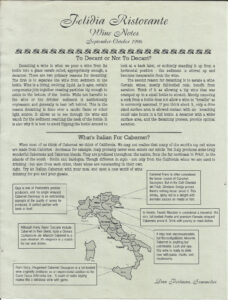 Felidia Ristorante
Felidia Ristorante
Wine Notes
September-October 1996
To Decant or Not To Decant?
Decanting a wine is when we pour a wine from its bottle into a glass carafe called, appropriately enough, a decanter. There are two primary reasons for decanting. The first is to separate the wine from sediment in the bottle. Wine is a living, evolving liquid. As it ages, certain components join together creating particles big enough to settle to the bottom of the bottle. While not harmful to the wine or the drinker, sediment is aesthetically unpleasant and generally is best left behind. This is the reason decanting is done over a candle flame or other light source. It allows us to see through the wine and watch for the sediment reaching the neck of the bottle. It is also why it is best to avoid flipping the bottle around to look at a back label, or suddenly standing it up from a horizontal position – the sediment is stirred up and becomes inseparable from the wine.
The second reason for decanting is to aerate a wine. Certain wines, mostly full-bodied reds, benefit from aeration. Think of it as allowing a big wine that was cramped up in a small bottle to stretch. Merely removing a cork from a bottle does not allow a wine to “breathe” as is commonly assumed. If you think about it only a dime sized surface area is allowed contact with air – breathing could take hours in a full bottle. A decanter with a wider surface area, and the decanting process, provide optimal aeration.
℘℘℘℘℘℘℘℘℘℘℘℘℘
What’s Italian For Cabernet?
When most of us think of Cabernet we think of California. We may not realize that many of the world’s top red wines are made from Cabernet – Bordeaux for example. Italy probably never even enters our minds. Yet Italy produces some truly wonderful Cabernets and Cabernet blends. They are produced throughout the nation, from the far northeast in Friuli, to the islands of the south – Sicilia and Sardegna. Though different in style – not only from the California wines we are used to drinking – but also from each other, these wines are outstanding in their own right. Try an Italian Cabernet with your meal and open a new world of wine drinking for you and your guests.
- Gaja is one of Piemonte’s premier producers, and his single vineyard Cabernet Darmagi is an outstanding example of the quality of wines he produces. A perfect partner wiht lamb or beef.
- Although many Super Tuscans include Cabernet in their blend, Isole e Olena‘s Collezione de Marchi Cabernet is a pure standout. Its elegance is a match for our veal dishes.
- From Sicily, Regaleali Cabernet Sauvignon is a full-bodied wine originally produced as an experimental addition to the Conte Tasca d’Almerita line. A touch of rustic styling makes this a delicious wine with game.
- Cabernet Franc is often considered the lesser cousin of Cabernet Sauvignon. But in the Colli Orientali del Friuli, Girolamo Dorigo proves there’s nothing lesser about it. This smoky, spicy red is a delight with aromatic sauces on meats or fish.
- In Veneto, Fausto Maculan is considered a maverick. His rich, full-bodied Fratta and premium Ferrata vineyard Cabernets prove it. drink with poultry or meat dishes.
- It may look unpronounceable, but Boccadigabbia‘s Akronte Cabernet is anything but undrinkable. Lush and ripe, this wine is ready to drink now with pasta, risotto, and mushrooms.